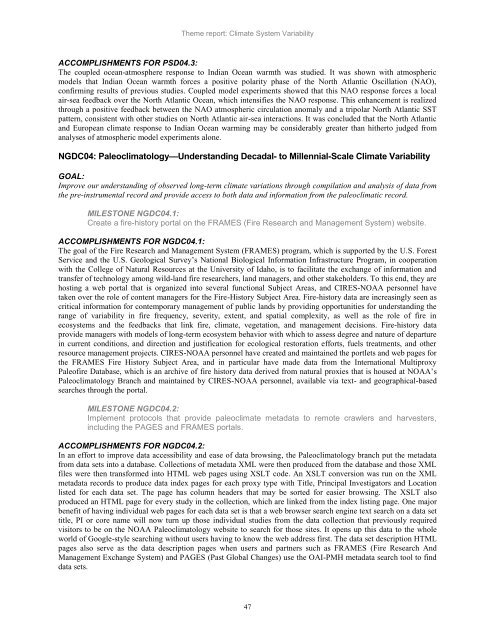Scientific Theme: Advanced Modeling and Observing Systems
Scientific Theme: Advanced Modeling and Observing Systems
Scientific Theme: Advanced Modeling and Observing Systems
Create successful ePaper yourself
Turn your PDF publications into a flip-book with our unique Google optimized e-Paper software.
<strong>Theme</strong> report: Climate System Variability<br />
ACCOMPLISHMENTS FOR PSD04.3:<br />
The coupled ocean-atmosphere response to Indian Ocean warmth was studied. It was shown with atmospheric<br />
models that Indian Ocean warmth forces a positive polarity phase of the North Atlantic Oscillation (NAO),<br />
confirming results of previous studies. Coupled model experiments showed that this NAO response forces a local<br />
air-sea feedback over the North Atlantic Ocean, which intensifies the NAO response. This enhancement is realized<br />
through a positive feedback between the NAO atmospheric circulation anomaly <strong>and</strong> a tripolar North Atlantic SST<br />
pattern, consistent with other studies on North Atlantic air-sea interactions. It was concluded that the North Atlantic<br />
<strong>and</strong> European climate response to Indian Ocean warming may be considerably greater than hitherto judged from<br />
analyses of atmospheric model experiments alone.<br />
NGDC04: Paleoclimatology—Underst<strong>and</strong>ing Decadal- to Millennial-Scale Climate Variability<br />
GOAL:<br />
Improve our underst<strong>and</strong>ing of observed long-term climate variations through compilation <strong>and</strong> analysis of data from<br />
the pre-instrumental record <strong>and</strong> provide access to both data <strong>and</strong> information from the paleoclimatic record.<br />
MILESTONE NGDC04.1:<br />
Create a fire-history portal on the FRAMES (Fire Research <strong>and</strong> Management System) website.<br />
ACCOMPLISHMENTS FOR NGDC04.1:<br />
The goal of the Fire Research <strong>and</strong> Management System (FRAMES) program, which is supported by the U.S. Forest<br />
Service <strong>and</strong> the U.S. Geological Survey‘s National Biological Information Infrastructure Program, in cooperation<br />
with the College of Natural Resources at the University of Idaho, is to facilitate the exchange of information <strong>and</strong><br />
transfer of technology among wild-l<strong>and</strong> fire researchers, l<strong>and</strong> managers, <strong>and</strong> other stakeholders. To this end, they are<br />
hosting a web portal that is organized into several functional Subject Areas, <strong>and</strong> CIRES-NOAA personnel have<br />
taken over the role of content managers for the Fire-History Subject Area. Fire-history data are increasingly seen as<br />
critical information for contemporary management of public l<strong>and</strong>s by providing opportunities for underst<strong>and</strong>ing the<br />
range of variability in fire frequency, severity, extent, <strong>and</strong> spatial complexity, as well as the role of fire in<br />
ecosystems <strong>and</strong> the feedbacks that link fire, climate, vegetation, <strong>and</strong> management decisions. Fire-history data<br />
provide managers with models of long-term ecosystem behavior with which to assess degree <strong>and</strong> nature of departure<br />
in current conditions, <strong>and</strong> direction <strong>and</strong> justification for ecological restoration efforts, fuels treatments, <strong>and</strong> other<br />
resource management projects. CIRES-NOAA personnel have created <strong>and</strong> maintained the portlets <strong>and</strong> web pages for<br />
the FRAMES Fire History Subject Area, <strong>and</strong> in particular have made data from the International Multiproxy<br />
Paleofire Database, which is an archive of fire history data derived from natural proxies that is housed at NOAA‘s<br />
Paleoclimatology Branch <strong>and</strong> maintained by CIRES-NOAA personnel, available via text- <strong>and</strong> geographical-based<br />
searches through the portal.<br />
MILESTONE NGDC04.2:<br />
Implement protocols that provide paleoclimate metadata to remote crawlers <strong>and</strong> harvesters,<br />
including the PAGES <strong>and</strong> FRAMES portals.<br />
ACCOMPLISHMENTS FOR NGDC04.2:<br />
In an effort to improve data accessibility <strong>and</strong> ease of data browsing, the Paleoclimatology branch put the metadata<br />
from data sets into a database. Collections of metadata XML were then produced from the database <strong>and</strong> those XML<br />
files were then transformed into HTML web pages using XSLT code. An XSLT conversion was run on the XML<br />
metadata records to produce data index pages for each proxy type with Title, Principal Investigators <strong>and</strong> Location<br />
listed for each data set. The page has column headers that may be sorted for easier browsing. The XSLT also<br />
produced an HTML page for every study in the collection, which are linked from the index listing page. One major<br />
benefit of having individual web pages for each data set is that a web browser search engine text search on a data set<br />
title, PI or core name will now turn up those individual studies from the data collection that previously required<br />
visitors to be on the NOAA Paleoclimatology website to search for those sites. It opens up this data to the whole<br />
world of Google-style searching without users having to know the web address first. The data set description HTML<br />
pages also serve as the data description pages when users <strong>and</strong> partners such as FRAMES (Fire Research And<br />
Management Exchange System) <strong>and</strong> PAGES (Past Global Changes) use the OAI-PMH metadata search tool to find<br />
data sets.<br />
47
















